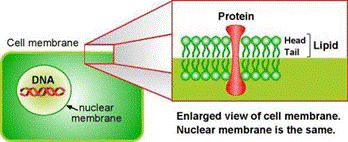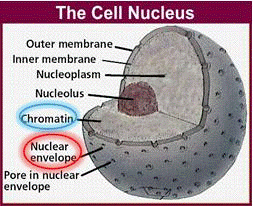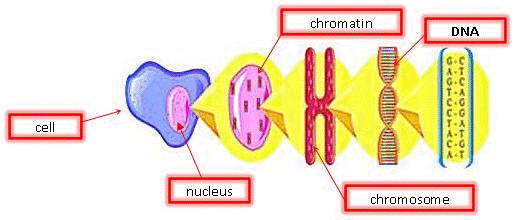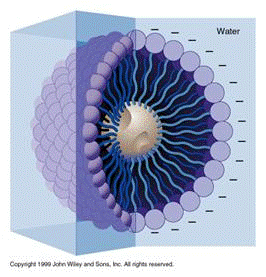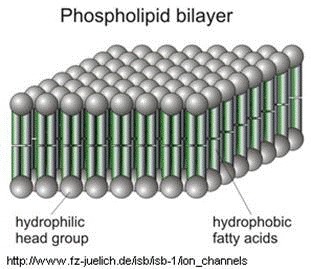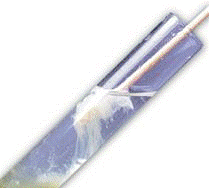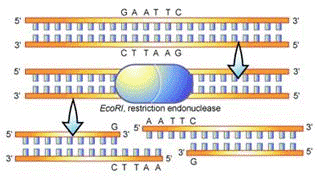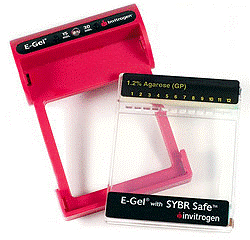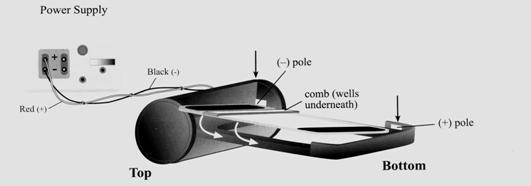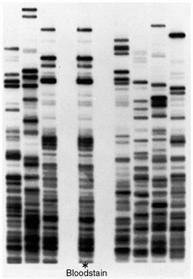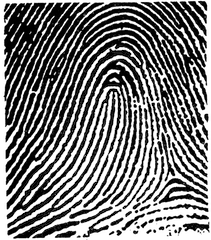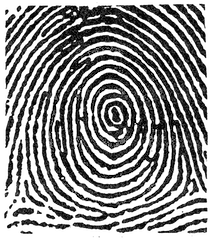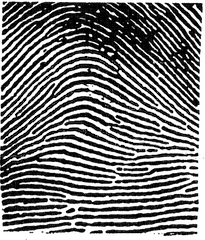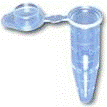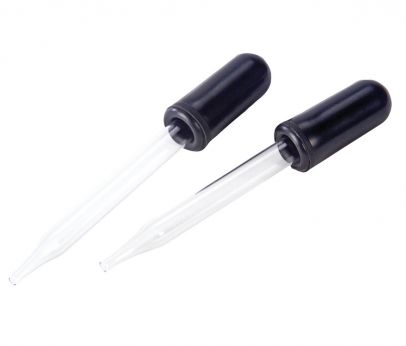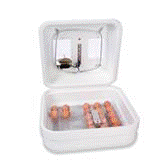Biomedical Forensics
Objectives
The objectives of this experiment are to extract DNA from a fruit sample, learn about fingerprinting, identify foreign substances and perform blood typing to investigate a crime scene. The DNA will be extracted using the basic biochemical techniques for isolating, purifying, and digesting DNA molecules. The drug test will be completed using various testers. A blood typing kit will be used for the blood tests.
Overview
Cellular Biology and Location of DNA
DNA is the blueprint of life and is found in almost all living organisms. These organisms can be as simple as a single-celled bacteria or as complex as a multi-celled human: the human body contains approximately 50 trillion cells. There are two different types of cells: prokaryotes and eukaryotes. An example of prokaryotic organism is bacteria. Prokaryotic cells do not contain a nuclear membrane and so do not have a distinct nucleus. Only eukaryotic cells, which make up plants and animals, will be considered in this lab. Eukaryotic cells have a distinct, membrane-bound nucleus that isolates the DNA from the rest of the cell. The structure of plant cells is different from those of animal cells in structure and cellular contents. Only plant cells will be used in this experiment.
Plant cells are surrounded by a cell wall. It has high mechanical strength and protects the cell. Directly beneath the cell wall lies the plasma membrane (Figure 1), which contains the cytosol. The various cell organelles, including the nucleus, are found within the cytosol. The nucleus houses the DNA in the form of chromatin.
Chromatin is the active form of DNA in the cell when it is not preparing for cell division. It is comprised of DNA wrapped around protein particles called histones.
DNA Extraction Technique
In this experiment, a goal is to extract the DNA from a fruit sample. Some knowledge of the scientific background behind DNA extraction is needed to do this.
The DNA extraction process is a fairly simple biochemical procedure that can be divided into three major steps: breaking open the cell (lysis), destroying membranes within the cell, and precipitating the DNA out of the solution.
The following sections describe how each step relates to the physical and biochemical properties of DNA.
Cell Lysis (Breaking Open the Cell Wall and Membranes)
Plant cells have a very rigid external structure — the cell wall — which protects it. To get to the DNA, the very first step would be to break open that wall.
The cell wall is the first barrier in that must be broken to extract the DNA molecule inside the cell. It is very rigid and acts as a protector and filter. It is made of cellulose, and is responsible for making wood hard and durable. To destroy the cell wall, a mechanical method is used to break apart the cellulose molecules. In this experiment, the fruit sample is mashed manually.
Destroying Membranes Within the Cell
The cell's plasma membrane is made of phospholipid bilayers; they are made of fat. To disrupt them, that mesh of fat molecules is broken up with soap. The structure of soap is very similar to that of fat and grease.
A soap molecule has two parts: a head and a tail. The head is polar and is attracted to water while the tail is non-polar and is attracted to oil and fat. When soap molecules are in water, they group themselves into micelles — a roughly spherical structure in which all the polar heads point outwards (in contact with water) and all the non-polar tails point inwards at the center of the sphere (away from the water). They can effectively trap the fat molecule inside the micelle and dissolve the cell membranes. How does this micelle break down the phospholipid bilayer? The molecules in the phospholipid bilayer (Figure 5) also contain molecules that are made up of a hydrophobic head and a hydrophilic tail. The soap molecules orient themselves so that their head associates with the tail of the phospholipid bilayer. In this way, the soap is able to break up the bilayer molecule by molecule.
Precipitating the DNA
When the membrane is successfully disrupted, the DNA is released from the cells into the solution along with protein molecules and other cellular miscellanea.
The DNA molecule is a double-helical polymer consisting of a sugar-phosphate backbone with nitrogenous bases running perpendicular to the backbone. These bases, often represented by letters — A (adenine), G (guanine), C (cytosine), and T (thymine) — are the elementary components making up the coded genetic information (Figure 7). The base sequence acts as the instruction manual of the cell, directing it on how to make proteins and other important molecules that an organism needs to survive and function.
With the cell's contents mixed into a solution, the DNA is separated from the rest; this process is called precipitation. Salt is used because it disrupts the structure of the proteins and carbohydrates found in the solution. Also, the salt provides a favorable environment to extract the DNA by contributing positively charged sodium ions that neutralize the negative charge of DNA. After the addition of salt and soap, the manner by which the DNA is being extracted out of the solution cannot be seen as it is too small to distinguish from the rest of the solution. To aid in precipitating the DNA, alcohol is added since it cannot dissolve DNA. A translucent white substance will begin to form at the top; this is DNA. Once it is thick enough, it can be spooled out. This simple procedure is a rough extraction process that needs further purification before it can be successfully run on a gel for analysis.
Restriction
Often times, larger fragments of DNA are cut, or restricted, to extract a particular fragment. This is made possible by the action of restriction enzymes, which are used by bacteria to cut up foreign or enemy DNA. Restriction enzymes are catalytic proteins that recognize specific palindromic DNA sequences and cut the double-stranded DNA at particular sites. The sites that the restriction enzymes recognize are called restriction sites. There are many different types of restriction enzymes. Each type recognizes a different restriction site. In this lab, Lambda DNA, which is a commercially available DNA normally found in a virus called Phage Lambda, will be restricted with the restriction enzyme BamH1.
| Enzyme | Source | Recognition Sequence | Cut | |
|---|---|---|---|---|
| BamH1 | Bacillus amyloliquefaciens | 5'GGATCC 3'CCTAGG |
5'-----G -------CCTAG |
GATCC------ G-----5' |
| EcoRI | Escherichia coli | 5'GGATCC 3'CCTAGG |
5'-----G -------CCTAG |
GATCC------ G-----5' |
| HindIII | Haemophilus influenzae | 5'AAGCTT 3'TTCGAA |
5'---A 3'---TTCGA |
AGCTT---3' A---5' |
Gel Electrophoresis
The technique of DNA electrophoresis (Figure 10), will be performed on uncut and cut Lambda DNA, a commercially available DNA on an agarose gel, to visualize the characteristic banding patterns that differentiate between different DNA fragments. Gel electrophoresis is a technique used for separating molecules based on their charge and molecular weight. The sample is loaded in a gel matrix and an electric field is applied across it. The electric field enables the DNA, which is negatively charged to migrate to the end, which is positively charged. Opposites attract and so the negatively charged DNA is attracted to the positive end of the gel. Lighter molecules will migrate to the opposite end of the gel faster than heavier molecules.
The following is a gel after the samples have been run. Each column is referred to as a lane, representing one sample each. The individual bands (Figure 11) contain fragments of DNA that are identical in weight.
Fingerprints
Fingerprints are unique patterns, made by friction ridges (raised) and furrows (recessed), which appear on the pads of the fingers and thumbs. Prints from palms, toes and feet are also unique; however, these are used less often for identification, so this guide focuses on prints from the fingers and thumbs.
The fingerprint pattern, such as the print left when an inked finger is pressed onto paper, is that of the friction ridges on that particular finger. Friction ridge patterns are grouped into three distinct types—loops, whorls, and arches—each with unique variations, depending on the shape and relationship of the ridges:
Loops are prints that recurve back on themselves to form a loop shape. Divided into radial loops (pointing toward the radius bone, or thumb) and ulnar loops (pointing toward the ulna bone, or pinky), loops account for approximately 60 percent of pattern types.
Whorls form circular or spiral patterns, like tiny whirlpools. There are four groups of whorls: plain (concentric circles), central pocket loop (a loop with a whorl at the end), double loop (two loops that create an S-like pattern) and accidental loop (irregular shaped). Whorls make up about 35 percent of pattern types.
Arches create a wave-like pattern and include plain arches and tented arches. Tented arches rise to a sharper point than plain arches. Arches make up about five percent of all pattern types.
Materials and Equipment
- Fruit sample
- Non-iodized table salt (NaCl)
- Hand soap (clear, unscented)
- 95% isopropyl alcohol (0 °C)
- Distilled water
- Strainer
- Plastic cups
- Ziploc bag
- Lambda DNA
- Dye
- Variable micropipette and tips
- Incubator
- Microcentrifuge tube
- Precast agarose gel
- Electrophoresis system
- Bioimaging system
- DNA sample containers
- Disposable pipets
- Iron Magic Wand
- Iron powder
- Arduino software
- Arduino moisture sensor
- Blood typing kit
- Milk, water, vinegar, dye
Procedure
Forensic Academy
Before you can go out into the field and investigate into your first crime, you must first go through basic training to become an official EG forensic scientist. In this time, three tests will be done to enhance your knowledge of the forensic science and how the modern forensic scientist would start an investigation.
Part 1: DNA Extraction
- Put a bottle of isopropyl alcohol in a freezer. We’ll come back to it later. Measure 6T (90 ml) of water into a small glass container.
- Stir in a ¼-tsp salt and mix until the salt dissolves. This is the extraction mixture.
- Stir in a ¼-tsp salt and mix until the salt dissolves. This is the extraction mixture.
- Place one banana into a plastic zipper-lock bag.
- Pour the extraction mixture into the bag with the banana.
- Remove as much air from the bag as possible and seal it closed.
- Use your hands and fingers to mash, smash, and moosh the strawberry inside of the bag. You don’t want any large pieces remaining.
- Pour the resulting strawberry pulp and extraction mixture through a strainer and into a medium glass bowl or similar container.
- Use a spoon to press the mashed bits of strawberry against the strainer forcing even more of the mixture into the container. 10. From the container it’s in now, pour the extraction mixture into a smaller glass container that holds ¼- to ½-cup (50-100 ml) of fluid. This will help to isolate the DNA on the surface of the mixture.
- Add 1 tsp (5 ml) of the chilled isopropyl alcohol to the solution and hold the mixture at eye level. You’re looking for a separation of material that shows up as a white layer on top. That’s the DNA of the strawberry!
- Use the tweezers to gently remove the DNA from the solution and lay it on a dish to examine.
Part 2: Fingerprinting
- Obtain a clean piece of Plexiglass and thoroughly clean it with a baby wipe.
- Apply your thumb onto the glass, and put pressure onto the glass, while holding the glass by its edges.
- Keep applying pressure for 30 seconds.
- Once the time is up, hold the glass against the light to view the imprint and is it if it came out clearly. If not, clean the glass and redo the process.
- Take the fingerprint powder and spread a generous amount in the region of the imprint.
- Take the magic wand and slowly lift the top to extract the excess iron filament from the glass panel.
- Place the excess back into the black powder container and seal the container.
- Closely observe the remaining fingerprint and identify which type of fingerprint it is.
Part 3: Drug Testing
- Obtain lab samples of the suspect drug.
- Separate the drug sample into 15 test tubes, label each test tube A1, A2, A3, B1, B2, B3, C1, C2, C3, D1, D2, D3, E1, E2, E3.
- Obtain the 5 drug identifiers from the TAs. Identifiers tests for the following drugs:
- Cannabis
- Heroin
- MDMA (Ecstasy)
- Cocaine
- Lysergic Acid Diethylamide (LSD)
- Take all the A-labelled test tubes with the drug sample and place 5 droplets of the Cannabis.
- Stir the test tube for 30 seconds.
- Observe each test tube. If the test tube has formed a fizzing substance, the powder contains that drug.
- Repeat Step 4-6 for each of the identifiers (Test Tube B-Heroin, Test Tube C-MDMA, Test Tube D- Cocaine, Test Tube E-LSD).
Part 4: Blood Splatter Analysis
Distance Test
- Measure a height of 15cm
- Using a pipette, administer a droplet of blood onto a piece of white paper
- Record the radius of the resulting droplet
- Repeat steps 1-3 for heights of 30cm, 60cm, 90cm, 135cm, 180cm
Angle Test
- From a height of 60 cm, administer a drop of blood at an angle of 90° from the horizon
- Record the length of the resulting droplet
- Repeat the step 1-2 for angles of 75°, 60°, 45°, 30°, 15°, 10° from the horizon
Congratulations, you have now completed the Forensic Academy and now are certified to fight crime in the greater EG area!
Crime Scene
It was a warm and stormy night on July 23rd, 2017. The EG office was quiet as one TA was pulling a late night shift to prepare the classroom for the next morning’s lab. There is a loud crash in the background. The room went dark. The next morning, there was police tape engulfing the entire room. Someone had murdered Roy, and now it is up to you to find his killer.
At the crime scene, police discovered a pool of blood, along with the suspected murder weapon, a hammer, near the body. They have narrowed down the suspects to the 26 people who had access to the office that late at night. Here is an excel of the basic information of the suspects:
(INSERT EXCEL LINK HERE)
It is up to you to find the killer before this case gets cold, and the murderer is never found.
Part 1: Biological Dimensional Analysis
- Obtain a piece of string and make a knot that is equal to the length of your foot
- Compare this string to various part of your body (ie. size of your head, arm length, leg length, hand size, overall height, etc.)
- Repeat steps for each member in group
- Compare the ratios of each body part ratios within the group
Assignment
Individual Lab Report
Follow the lab report guidelines laid out in the page called Specifications for Writing Your Lab Reports in the Technical Communication section of this manual. The following discussion points should be addressed in the appropriate section of the lab report:
- Discuss the structure of a plant cell.
- Justify the use of salt, soap, and alcohol in the extraction procedure.
- Explain how to reach the DNA and the barriers that were overcome to get to it.
- Describe the major techniques used in this lab: DNA Restriction, Gel Electrophoresis, etc.
- Important properties of DNA directly having an impact on the extraction procedure.
- Clearly describe the procedural steps the way they were carried out in lab.
- Describe the steps carried out with the TA.
- Explain the test results for the Biuret test and Benedict's test.
- Include appropriate figures to support the observations made.
- Specify the location in the gel of the DNA sample that belonged to the team.
- Compare the results with the control group.
- How would procedure change if meat was used instead of fruit?
Remember: Lab notes must be taken. Experimental details are easily forgotten unless written down. EG1004 Lab Notes Paper can be downloaded and printed from the EG1004 Website. Use the lab notes to write the Procedure section of the lab report. At the end of each lab, a TA will scan the lab notes and upload them to the Lab Documents section of the EG1004 Website. One point of extra credit is awarded if the lab notes are attached at the end of the lab report. Keeping careful notes is an essential component of all scientific practice.
Team PowerPoint Presentation
Follow the presentation guidelines laid out in the page called EG1003 Lab Presentation Format in the Introduction to Technical Presentations section of this manual. When preparing the presentation, consider the following points:
- Rely heavily on graphics and pictures.
- Make sure the Experimental Work is described simply and thoroughly.
- Discuss the real-life application of DNA sequencing.
- Demonstrate clear understanding of each procedural step carried out and why it worked.
References
Nasco Website
The Science Creative Quarterly
http://www.hhmi.princeton.edu/documents/labprotocols
http://porpax.bio.miami.edu/~cmallery/255/255chem/255chemistry.htm
http://library.thinkquest.org/20465/DNAstruct.html
| ||||||||
